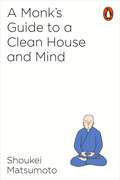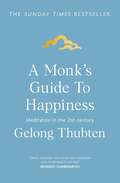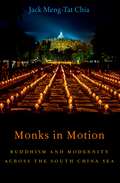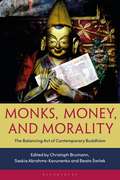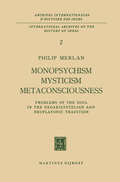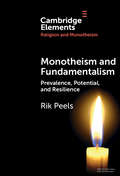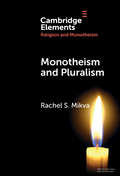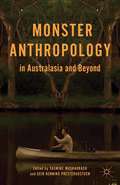- Table View
- List View
The Monk and the Book: Jerome and the Making of Christian Scholarship
by Megan Hale WilliamsIn the West, monastic ideals and scholastic pursuits are complementary; monks are popularly imagined copying classics, preserving learning through the Middle Ages, and establishing the first universities. But this dual identity is not without its contradictions. While monasticism emphasizes the virtues of poverty, chastity, and humility, the scholar, by contrast, requires expensive infrastructure—a library, a workplace, and the means of disseminating his work. In The Monk and the Book, Megan Hale Williams argues that Saint Jerome was the first to represent biblical study as a mode of asceticism appropriate for an inhabitant of a Christian monastery, thus pioneering the enduring linkage of monastic identities and institutions with scholarship. Revisiting Jerome with the analytical tools of recent cultural history—including the work of Bourdieu, Foucault, and Roger Chartier—Williams proposes new interpretations that remove obstacles to understanding the life and legacy of the saint. Examining issues such as the construction of Jerome’s literary persona, the form and contents of his library, and the intellectual framework of his commentaries, Williams shows that Jerome’s textual and exegetical work on the Hebrew scriptures helped to construct a new culture of learning. This fusion of the identities of scholar and monk, Williams shows, continues to reverberate in the culture of the modern university. "[Williams] has written a fascinating study, which provides a series of striking insights into the career of one of the most colorful and influential figures in Christian antiquity. Jerome's Latin Bible would become the foundational text for the intellectual development of the West, providing words for the deepest aspirations and most intensely held convictions of an entire civilization. Williams's book does much to illumine the circumstances in which that fundamental text was produced, and reminds us that great ideas, like great people, have particular origins, and their own complex settings."—Eamon Duffy, New York Review of Books
Monkey Boy: Finalist For The 2022 Pulitzer Prize For Fiction
by Francisco Goldman'Goldman is a natural storyteller - funny, intimate, sarcastic, all-noticing.' James Wood, The New YorkerFrancisco Goldberg has been living and working in Mexico City as a journalist for over a decade, but has recently returned to New York City in hopes of 'going home again.' It's been five years since the end of his last relationship and he is falling in love again. Soon he is beckoned back to Boston by the high school girlfriend who was witness to his greatest youthful humiliations, and his mother, Yolanda, around whom his story orbits like a dark star. Backdropping this five-day trip to his childhood home is the spectre of Frank's recently deceased father, Bert, an immigrant from Ukraine, volcanically tempered, pathologically abusive, yet also at times infuriatingly endearing; as well as the high school bullies who gave him the moniker 'monkey boy' and his estranged sister, Lexi.Told in an open, irresistibly funny and passionate voice, this extraordinary portrait of growing up outside the dominant culture unearths the hidden cruelties in a predominantly white, working-class Boston suburb where Francisco - aka Paco, aka Frankie Gee - came of age. A crowning achievement from one of the most important American voices of the last 40 years.
Monkey Trials and Gorilla Sermons: Evolution and Christianity from Darwin to Intelligent Design (New Histories of Science, Technology, and Medicine)
by Peter J. BowlerFrom the beginning, Darwin’s dangerous idea has been a snake in the garden, denounced from pulpits then and now as incompatible with the central tenets of Christian faith. Recovered here is the less well-known but equally long history of thoughtful engagement and compromise on the part of liberal theologians. Peter J. Bowler doesn’t minimize the hostility of many of the faithful toward evolution, but he reveals the existence of a long tradition within the churches that sought to reconcile Christian beliefs with evolution by finding reflections of the divine in scientific explanations for the origin of life. By tracing the historical forerunners of these rival Christian responses, Bowler provides a valuable alternative to accounts that stress only the escalating confrontation. Our polarized society, Bowler says, has all too often projected its rivalries onto the past, concealing the efforts by both scientists and theologians to find common ground. Our perception of past confrontations has been shaped by an oversimplified model of a “war” between science and religion. By uncovering the complexity of the debates sparked by Darwin’s theory, we might discover ways to depolarize our own debates about where we came from and why we are here.
The Monks and Monasteries of Constantinople, CA. 350-850 (PDF)
by Peter HatlieBetween 350 and 850 Constantinople emerged as both the greatest city of the Mediterranean world and a monastic center of unparalleled importance. Drawing upon a wide range of sources, including a rich body of hagiographical evidence, this study documents the historical relationship between the city and its monks during this crucial formative period. Monks and nuns played a key role from the beginning. In 350 their numbers were few, yet their impact on local politics and the church was significant. By 850 their presence was felt everywhere – from the world of the imperial court and church, to the local economy, elite culture, social services and popular piety. This dramatic rise in the influence of local monasticism was the result of its impressive numerical growth over time, and hard-won success in adapting the singular call of the monastic life to the challenges of the great medieval metropolis and imperial capital.
The Monk's Cell: Ritual and Knowledge in American Contemplative Christianity
by Paula PryceThe call to contemplative Christianity is not an easy one. Those who answer it set themselves to the arduous task of self-reformation through rigorous study and practice, learned through the teachings of monks and nuns and the writings of ancient Christian mystics, often in isolation from family and friends. Those who are dedicated can spend hours every day in meditation, prayer, liturgy, and study. Why do they come? Indeed, how do they find their way to the door at all? Based on nearly four years of research among semi-cloistered Christian monastics and a dispersed network of non-monastic Christian contemplatives across the United States and around the globe, The Monk's Cell shows how religious practitioners in both settings combined social action and intentional living with intellectual study and intensive contemplative practices in an effort to modify their ways of knowing, sensing, and experiencing the world. Organized by the metaphor of a seeker journeying towards the inner chambers of a monastic chapel, The Monk's Cell uses innovative "intersubjective fieldwork" methods to study these opaque, interiorized, often silent communities, in order to show how practices like solitude, chant, contemplation, attention, and a paradoxical capacity to combine ritual with intentional "unknowing" develop and hone a powerful sense of communion with the world.
The Monk's Cell: Ritual and Knowledge in American Contemplative Christianity
by Paula PryceThe call to contemplative Christianity is not an easy one. Those who answer it set themselves to the arduous task of self-reformation through rigorous study and practice, learned through the teachings of monks and nuns and the writings of ancient Christian mystics, often in isolation from family and friends. Those who are dedicated can spend hours every day in meditation, prayer, liturgy, and study. Why do they come? Indeed, how do they find their way to the door at all? Based on nearly four years of research among semi-cloistered Christian monastics and a dispersed network of non-monastic Christian contemplatives across the United States and around the globe, The Monk's Cell shows how religious practitioners in both settings combined social action and intentional living with intellectual study and intensive contemplative practices in an effort to modify their ways of knowing, sensing, and experiencing the world. Organized by the metaphor of a seeker journeying towards the inner chambers of a monastic chapel, The Monk's Cell uses innovative "intersubjective fieldwork" methods to study these opaque, interiorized, often silent communities, in order to show how practices like solitude, chant, contemplation, attention, and a paradoxical capacity to combine ritual with intentional "unknowing" develop and hone a powerful sense of communion with the world.
A Monk's Guide to a Clean House and Mind: Housekeeping Secrets From The World's Tidiest Monks
by Shoukei MatsumotoCleanliness is next to enlightenment. In this Japanese bestseller a Buddhist monk explains the traditional cleaning techniques that will help cleanse not only your house - but your soul.'We remove dust to sweep away our worldly desires. We scrub dirt to free ourselves of attachments. We live simply and take time to contemplate the self, mindfully living each moment. It's not just monks that need to live this way. Everyone in today's busy world today needs it.The Zen sect of Buddhism is renowned for the cleanliness of its monks, but cleaning is greatly valued in Japanese Buddhism in general as a way to cultivate the mind. In this book, I introduce everyday cleaning methods typically employed in temples, while sharing what it's like to be a monk in training.This book will improve the condition not just of your own mind, but also the people around you. I hope readers will discover that cleanliness is an opportunity to contemplate oneself.'
A Monk's Guide to Happiness: Meditation in the 21st century
by Gelong Thubten'Thubten is a very generous and kind monk who writes with the lived honesty and humour of someone who has experienced the wisdom he shares. His writing is full of inspiration but also the pragmatism needed to form a sustainable practice. His book clearly illustrates why we all need meditation and mindfulness in our lives.'- Benedict Cumberbatch What is the secret to being happy? Does happiness come from outside us or do we need to look within? Can meditation help?Gelong Thubten has worked with everyone from Silicon Valley entrepreneurs to Ruby Wax and Benedict Cumberbatch. In his warm and engaging debut book he explores the nature of happiness and explains how to bring meditation into our busy 21st-century lives with simple yet effective exercises.Gelong Thubten, Buddhist monk, meditation teacher and author, has always been fascinated by the question of happiness. In his youth he tried to find it through living a wild and extreme lifestyle as an actor in New York. This only led to more unhappiness. Desperate for solutions, he found himself at a Buddhist monastery where he became a monk. After training his mind in intensive retreats he now helps many thousands of people worldwide, showing them how to find inner happiness and a greater sense of freedom.His book can help you:- Learn practical methods that help you to choose happiness - Develop greater compassion for yourself and others - Learn how to meditate in micro-moments during a busy day - Discover that you are naturally 'hard-wired' for happinessIn this profound and inspiring book, Gelong Thubten presents a practical and sustainable approach to happiness, and how meditation and mindfulness can help us get there. Thubten helps to bust the myth that our lives and minds are too busy for meditation. Reading this book could revolutionise your relationship with your thoughts and emotions.'Gelong Thubten's book is as warm, wise and generous as the man himself. We've never needed a voice like his more.'- Melanie Reid, The Times'Compelling to read, yet full of profound wisdom, this wonderful book rationally describes how our mind functions and how we can cultivate the habit of happiness.' - Professor Lokesh Joshi, Vice President for Research, National University of Ireland'Thubten is able to explain meditation using clear language and an approach which really speaks to our modern tech-infused lives. With openness, humility and humour he delivers a deep message that will resonate in our modern culture.' - Rami Jawhar, Progam Manager at Google Arts & Culture'Gelong Thubten's wonderful book provides a bracing challenge to our search for instant gratification and "instant" happiness, and a lucid, practical, step-by-step path to contentment and a genuine and lasting peace of mind.'- Mick Brown, journalist for The Daily Telegraph
Monks in Motion: Buddhism and Modernity Across the South China Sea (AAR Academy Series)
by Jack Meng-Tat ChiaChinese Buddhists have never remained stationary. They have always been on the move. In Monks in Motion, Jack Meng-Tat Chia explores why Buddhist monks migrated from China to Southeast Asia, and how they participated in transregional Buddhist networks across the South China Sea. This book tells the story of three prominent monks Chuk Mor (1913-2002), Yen Pei (1917-1996), and Ashin Jinarakkhita (1923-2002) and examines the connected history of Buddhist communities in China and maritime Southeast Asia in the twentieth century. Monks in Motion is the first book to offer a history of what Chia terms "South China Sea Buddhism," referring to a Buddhism that emerged from a swirl of correspondence networks, forced exiles, voluntary visits, evangelizing missions, institution-building campaigns, and the organizational efforts of countless Chinese and Chinese diasporic Buddhist monks. Drawing on multilingual research conducted in Indonesia, Malaysia, Singapore, China, Hong Kong, and Taiwan, Chia challenges the conventional categories of "Chinese Buddhism" and "Southeast Asian Buddhism" by focusing on the lesser-known--yet no less significant--Chinese Buddhist communities of maritime Southeast Asia. By crossing the artificial spatial frontier between China and Southeast Asia, Monks in Motion breaks new ground, bringing Southeast Asia into the study of Chinese Buddhism and Chinese Buddhism into the study of Southeast Asia.
Monks in Motion: Buddhism and Modernity Across the South China Sea (AAR Academy Series)
by Jack Meng-Tat ChiaChinese Buddhists have never remained stationary. They have always been on the move. In Monks in Motion, Jack Meng-Tat Chia explores why Buddhist monks migrated from China to Southeast Asia, and how they participated in transregional Buddhist networks across the South China Sea. This book tells the story of three prominent monks Chuk Mor (1913-2002), Yen Pei (1917-1996), and Ashin Jinarakkhita (1923-2002) and examines the connected history of Buddhist communities in China and maritime Southeast Asia in the twentieth century. Monks in Motion is the first book to offer a history of what Chia terms "South China Sea Buddhism," referring to a Buddhism that emerged from a swirl of correspondence networks, forced exiles, voluntary visits, evangelizing missions, institution-building campaigns, and the organizational efforts of countless Chinese and Chinese diasporic Buddhist monks. Drawing on multilingual research conducted in Indonesia, Malaysia, Singapore, China, Hong Kong, and Taiwan, Chia challenges the conventional categories of "Chinese Buddhism" and "Southeast Asian Buddhism" by focusing on the lesser-known--yet no less significant--Chinese Buddhist communities of maritime Southeast Asia. By crossing the artificial spatial frontier between China and Southeast Asia, Monks in Motion breaks new ground, bringing Southeast Asia into the study of Chinese Buddhism and Chinese Buddhism into the study of Southeast Asia.
Monks, Money, and Morality: The Balancing Act of Contemporary Buddhism
by Christoph Brumann, Saskia Abrahms-Kavunenko, and Beata ŚwitekVibrantly engaging contemporary Buddhist lives, this book focuses on the material and financial relations of contemporary monks, temples, and laypeople. It shows that rather than being peripheral, economic exchanges are key to religious debate in Buddhist societies. Based on long-term ethnographic fieldwork in countries ranging from India to Japan, including all three major Buddhist traditions, the book addresses the flows of goods and services between clergy and laity, the management of resources, the treatment of money, and the role of the state in temple economies. Along with documenting ritual and economic practices, these accounts deal with the moral challenges that Buddhist adherents are facing today, thereby bringing lived experience to the study of an often-romanticized religion.
Monks, Money, and Morality: The Balancing Act of Contemporary Buddhism
Vibrantly engaging contemporary Buddhist lives, this book focuses on the material and financial relations of contemporary monks, temples, and laypeople. It shows that rather than being peripheral, economic exchanges are key to religious debate in Buddhist societies. Based on long-term ethnographic fieldwork in countries ranging from India to Japan, including all three major Buddhist traditions, the book addresses the flows of goods and services between clergy and laity, the management of resources, the treatment of money, and the role of the state in temple economies. Along with documenting ritual and economic practices, these accounts deal with the moral challenges that Buddhist adherents are facing today, thereby bringing lived experience to the study of an often-romanticized religion.
Monks of Kublai Khan, Emperor of China: Medieval Travels from China Through Central Asia to Persia and Beyond
by Rabban SawmaTowards the end of the thirteenth century the Nestorian monk, Rabban Sawma, together with his disciple Mark, set out from Khanbaliq (Beijing), the capital city of Kublai Khan's Mongol Empire, on a pilgrimage to Jerusalem. Travelling through northern China and Central Asia they arrived at Maraghah, capital city of the Ilkhanate that was Mongol-ruled Persia. Military unrest prevented them from ever reaching Jerusalem but they did reah Baghdad, where Rabban Sawma spent many years. Summoned by Arghun Khan, the Ilkhan ruler and grand nephew of Kublai Khan, Sawma was made Ilkhanid ambassador and sent to Europe, first travelling to Constantinople to meet the Byzantine emperor and then to meet the kings of France and England as well as Pope Nicholas IV. Sawma's disciple, Mark, became the Nestorian Catholicus. Sawma's account of his travels provides unique information on the Ilkhans of Perisa and their dealings with the Mongol Christians as well as the events that led to the downfall of the Nestorian Church in China and further offers a unique picture of Medieval Europe through Asian eyes. Translated by Sir E.A.Wallis Budge, who also included a substantial introduction, the work is now rare. This edition contains a new introduction by Professor David Morgan, the leading scholar of the Mongol period.
Monks of Kublai Khan, Emperor of China: Medieval Travels from China Through Central Asia to Persia and Beyond
by Rabban SawmaTowards the end of the thirteenth century the Nestorian monk, Rabban Sawma, together with his disciple Mark, set out from Khanbaliq (Beijing), the capital city of Kublai Khan's Mongol Empire, on a pilgrimage to Jerusalem. Travelling through northern China and Central Asia they arrived at Maraghah, capital city of the Ilkhanate that was Mongol-ruled Persia. Military unrest prevented them from ever reaching Jerusalem but they did reah Baghdad, where Rabban Sawma spent many years. Summoned by Arghun Khan, the Ilkhan ruler and grand nephew of Kublai Khan, Sawma was made Ilkhanid ambassador and sent to Europe, first travelling to Constantinople to meet the Byzantine emperor and then to meet the kings of France and England as well as Pope Nicholas IV. Sawma's disciple, Mark, became the Nestorian Catholicus. Sawma's account of his travels provides unique information on the Ilkhans of Perisa and their dealings with the Mongol Christians as well as the events that led to the downfall of the Nestorian Church in China and further offers a unique picture of Medieval Europe through Asian eyes. Translated by Sir E.A.Wallis Budge, who also included a substantial introduction, the work is now rare. This edition contains a new introduction by Professor David Morgan, the leading scholar of the Mongol period.
Monopoly on Salvation?: A Feminist Approach to Religious Pluralism
by Jeannine Hill FletcherIn a world where religion often fuels ethnic and racial conflicts, and where passionate allegiance to rival creeds engenders violent antagonism among members of the same family, dwellers in the same neighborhood, citizens of the same country, no one can doubt the need to rethink the universalist claims of temple, church, and mosque. For the past few decades, Christian theology tended to regard religious difference as a "problem" to be overcome. More recently there has been an effort, however tentative, to view the different religious traditions as rich legacies to be shared by the entire human community. Monopoloy on Salvation? Re-examines missionary history to provide examples of how Christians have engaged across religious boundaries in the past--among them, Paul's letters, the Acts of Thomas, the colonial encounters of Christopher Columbus and Bartolome de las Casas, the missionary engagements of Francis Xavier, Roberto DeNobili, and Matteo Ricci, and modern missions in Africa and India. These representative accounts are seen not only through Christian eyes but also from a perspective of people of other faiths. All this provides the theoretical foundation for a Christian partnership in coequal religious dialogue. But practical resources, as the author shows, are necessary to effectively structure the conversation. A feminist analysis of human identity as multifaceted and intrinsically hybrid provides the insights for engaging across different religious visions without erasing distinctiveness. The culmination of the book is a theology modeled on the life, practice, and witness of Jesus of Nazareth that is open to the many patterns of diverse religions as gifts to humankind.
Monopsychism Mysticism Metaconsciousness: Problems of the Soul in the Neoaristotelian and Neoplatonic Tradition (Archives Internationales D'Histoire Des Idées Minor #2)
by Philip MerlanMonotheism and Divine Aggression (Elements in Religion and Monotheism)
by null Collin CornellThe aggression of the biblical God is notorious. The phrase 'Old Testament God' conjures up images of jealousy and wrath, smiting and judging. But is it only an accident that this god became capital-G God, the unique creator and sustainer of three world religions? Or is there a more substantive connection between monotheism and divine aggression? This Element proposes exactly this causal connection. In three case studies, it showcases ways that literarily treating one god alone as god amplifies divine destructiveness. This happens according to two dynamics: God absorbs the destructive power of other divine beings-and God monopolizes divinity such that other beings, even special ones like God's beloved king or the people of God, are rendered vulnerable to divine aggression. The Element also attends to the literary contexts and counterbalances within which the Hebrew Bible imagines divine aggression.
Monotheism and Fundamentalism: Prevalence, Potential, and Resilience (Elements in Religion and Monotheism)
by null Rik PeelsThis Element explores the relation between monotheism and fundamentalism. It does so from both an empirical perspective and a more theoretical one that combines theological and philosophical insights. The empirical part addresses how as a matter of fact, particularly quantitively, monotheism and fundamentalism relate to one another. The more theoretical part studies the relation between the two by considering the doctrine of God and the issue of exclusion, theories of revelation, and ethics. Finally, the book considers whether monotheism has particular resources that can be employed in mitigating the consequences of or even altogether preventing fundamentalism. This title is also available as Open Access on Cambridge Core.
Monotheism and Pluralism (Elements in Religion and Monotheism)
by null Rachel S. MikvaCan monotheistic traditions affirm the comparable value of diverse religions? Can they celebrate our world's multiple spiritual paths? This Element explores historical foundations and contemporary paradigms for pluralism in Judaism, Christianity, and Islam. Recognizing that there are other ways to interpret the traditions, it excavates the space for theological parity.
Monotheism and Yahweh's Appropriation of Baal (The Library of Hebrew Bible/Old Testament Studies #617)
by James S. AndersonBiblical scholarship today is divided between two mutually exclusive concepts of the emergence of monotheism: an early-monotheistic Yahwism paradigm and a native-pantheon paradigm. This study identifies five main stages on Israel's journey towards monotheism. Rather than deciding whether Yahweh was originally a god of the Baal-type or of the El-type, this work shuns origins and focuses instead on the first period for which there are abundant sources, the Omride era. Non-biblical sources depict a significantly different situation from the Baalism the Elijah cycle ascribes to King Achab. The novelty of the present study is to take this paradox seriously and identify the Omride dynasty as the first stage in the rise of Yahweh as the main god of Israel. Why Jerusalem later painted the Omrides as anti-Yahweh idolaters is then explained as the need to distance itself from the near-by sanctuary of Bethel by assuming the Omride heritage without admitting its northern Israelite origins. The contribution of the Priestly document and of Deutero-Isaiah during the Persian era comprise the next phase, before the strict Yahwism achieved in Daniel 7 completes the emergence of biblical Yahwism as a truly monotheistic religion.
The Monotheists: The Peoples of God
by F. E. PetersThe world's three great monotheistic religions have spent most of their historical careers in conflict or competition with each other. And yet in fact they sprung from the same spiritual roots and have been nurtured in the same historical soil. This book--an extraordinarily comprehensive and approachable comparative introduction to these religions--seeks not so much to demonstrate the truth of this thesis as to illustrate it. Frank Peters, one of the world's foremost experts on the monotheistic faiths, takes Judaism, Christianity, and Islam, and after briefly tracing the roots of each, places them side by side to show both their similarities and their differences. Volume I, The Peoples of God, tells the story of the foundation and formation of the three monotheistic communities, of their visible, historical presence. Volume II, The Words and Will of God, is devoted to their inner life, the spirit that animates and regulates them. Peters takes us to where these religions live: their scriptures, laws, institutions, and intentions; how each seeks to worship God and achieve salvation; and how they deal with their own (orthodox and heterodox) and with others (the goyim, the pagans, the infidels). Throughout, he measures--but never judges--one religion against the other. The prose is supple, the method rigorous. This is a remarkably cohesive, informative, and accessible narrative reflecting a lifetime of study by a single recognized authority in all three fields. The Monotheists is a magisterial comparison, for students and general readers as well as scholars, of the parties to one of the most troubling issues of today--the fierce, sometimes productive and often destructive, competition among the world's monotheists, the siblings called Jews, Christians, and Muslims.
The Monotheists: The Peoples of God
by F. E. PetersThe world's three great monotheistic religions have spent most of their historical careers in conflict or competition with each other. And yet in fact they sprung from the same spiritual roots and have been nurtured in the same historical soil. This book--an extraordinarily comprehensive and approachable comparative introduction to these religions--seeks not so much to demonstrate the truth of this thesis as to illustrate it. Frank Peters, one of the world's foremost experts on the monotheistic faiths, takes Judaism, Christianity, and Islam, and after briefly tracing the roots of each, places them side by side to show both their similarities and their differences. Volume I, The Peoples of God, tells the story of the foundation and formation of the three monotheistic communities, of their visible, historical presence. Volume II, The Words and Will of God, is devoted to their inner life, the spirit that animates and regulates them. Peters takes us to where these religions live: their scriptures, laws, institutions, and intentions; how each seeks to worship God and achieve salvation; and how they deal with their own (orthodox and heterodox) and with others (the goyim, the pagans, the infidels). Throughout, he measures--but never judges--one religion against the other. The prose is supple, the method rigorous. This is a remarkably cohesive, informative, and accessible narrative reflecting a lifetime of study by a single recognized authority in all three fields. The Monotheists is a magisterial comparison, for students and general readers as well as scholars, of the parties to one of the most troubling issues of today--the fierce, sometimes productive and often destructive, competition among the world's monotheists, the siblings called Jews, Christians, and Muslims.
The Monotheists: The Words and Will of God
by F. E. PetersThe world's three great monotheistic religions have spent most of their historical careers in conflict or competition with each other. And yet in fact they sprung from the same spiritual roots and have been nurtured in the same historical soil. This book--an extraordinarily comprehensive and approachable comparative introduction to these religions--seeks not so much to demonstrate the truth of this thesis as to illustrate it. Frank Peters, one of the world's foremost experts on the monotheistic faiths, takes Judaism, Christianity, and Islam, and after briefly tracing the roots of each, places them side by side to show both their similarities and their differences. Volume I, The Peoples of God, tells the story of the foundation and formation of the three monotheistic communities, of their visible, historical presence. Volume II, The Words and Will of God, is devoted to their inner life, the spirit that animates and regulates them. Peters takes us to where these religions live: their scriptures, laws, institutions, and intentions; how each seeks to worship God and achieve salvation; and how they deal with their own (orthodox and heterodox) and with others (the goyim, the pagans, the infidels). Throughout, he measures--but never judges--one religion against the other. The prose is supple, the method rigorous. This is a remarkably cohesive, informative, and accessible narrative reflecting a lifetime of study by a single recognized authority in all three fields. The Monotheists is a magisterial comparison, for students and general readers as well as scholars, of the parties to one of the most troubling issues of today--the fierce, sometimes productive and often destructive, competition among the world's monotheists, the siblings called Jews, Christians, and Muslims.
The Monotheists: The Words and Will of God
by F. E. PetersThe world's three great monotheistic religions have spent most of their historical careers in conflict or competition with each other. And yet in fact they sprung from the same spiritual roots and have been nurtured in the same historical soil. This book--an extraordinarily comprehensive and approachable comparative introduction to these religions--seeks not so much to demonstrate the truth of this thesis as to illustrate it. Frank Peters, one of the world's foremost experts on the monotheistic faiths, takes Judaism, Christianity, and Islam, and after briefly tracing the roots of each, places them side by side to show both their similarities and their differences. Volume I, The Peoples of God, tells the story of the foundation and formation of the three monotheistic communities, of their visible, historical presence. Volume II, The Words and Will of God, is devoted to their inner life, the spirit that animates and regulates them. Peters takes us to where these religions live: their scriptures, laws, institutions, and intentions; how each seeks to worship God and achieve salvation; and how they deal with their own (orthodox and heterodox) and with others (the goyim, the pagans, the infidels). Throughout, he measures--but never judges--one religion against the other. The prose is supple, the method rigorous. This is a remarkably cohesive, informative, and accessible narrative reflecting a lifetime of study by a single recognized authority in all three fields. The Monotheists is a magisterial comparison, for students and general readers as well as scholars, of the parties to one of the most troubling issues of today--the fierce, sometimes productive and often destructive, competition among the world's monotheists, the siblings called Jews, Christians, and Muslims.
Monster Anthropology in Australasia and Beyond
by Yasmine Musharbash Geir Henning PresterudstuenOffering a dialogue between anthropology and literature, culture, and media, this book presents fine-grained ethnographic vignettes of monsters dwelling in the contemporary world. These monsters hail from Aboriginal Australia, the Pacific, Asia, and Europe, and their presence is inextricably intertwined with the lives of those they haunt.





